(完整word版)英语时态(初中英语动词时态归纳总结对照表)
(完整版)英语动词时态归纳总结对照表
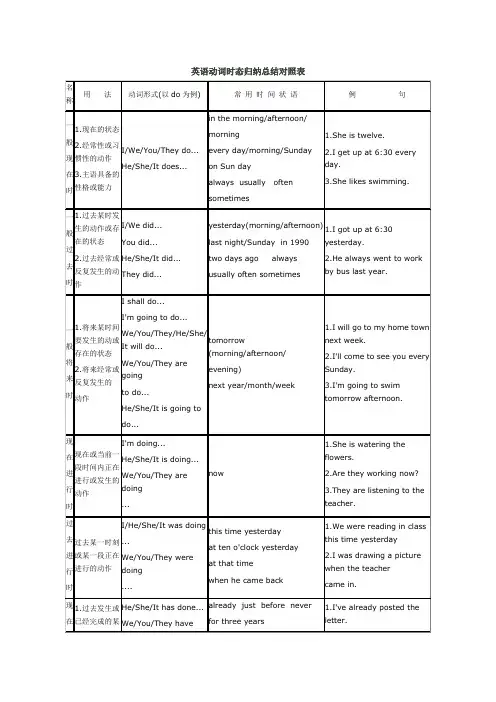
英语动词时态归纳总结对照表英语时态专项练习1、一般现在时。
通常用“usually, often, every day, sometimes”。
一般现在时基本用法介绍一、一般现在时的功能1.表示事物或人物的特征、状态。
如:The sky is blue.天空是蓝色的。
2.表示经常性或习惯性的动作。
如:I get up at six every day.我每天六点起床。
3.表示客观现实。
如:The earth goes around the sun.地球绕着太阳转。
二、一般现在时的构成:肯定句:1).主语+系动词 be(is, am, are )+名词(形容词,介词短语)2) .其他主语+动词原形+其它第三人称单数+动词-s+其它如:I am a boy.我是一个男孩。
We study English.我们学习英语。
Mary likes Chinese.玛丽喜欢汉语。
三、一般现在时的变化否定句:1)主语+ be (is,am,are)+ not +其它。
如:He is not a worker.他不是工人。
2)其他主语+do not(don’t)动词原形+其它I don't like bread第三人称单数+does not(doesn’t)动词原形+其它He doesn't often play.一般疑问句:1)Be(Is,Are) +主语+其它?如:-Are you a student? -Yes. I am. / No, I'm not.2)Do其他主语+动词原形+其它?Does+第三人称单数+动词原形+其它+?注意:遇I/we—you, my—your, some—any.Does she go to work by bike? - Yes, she does. / No, she doesn't.Do you often play football?- Yes, I do. / No, I don't.特殊疑问句:疑问词+一般疑问句。
英语时态全归纳表

英语时态全归纳表英语时态分为简单时态、进行时态、完成时态和完成进行时态,每个时态都有不同的形式和用法。
1. 简单时态(Simple Tenses):1) 现在时态(Present Tense)形式:主语 + 动词原形(第三人称单数加-s)用法:表示现在正在进行的动作、习惯性的动作或客观事实。
2) 过去时态(Past Tense)形式:主语 + 动词过去式用法:表示过去已经完成的动作或状态。
3) 将来时态(Future Tense)形式:主语 + will/shall + 动词原形用法:表示将来要发生的动作或事件。
2. 进行时态(Progressive Tenses):1) 现在进行时态(Present Progressive Tense)形式:主语 + am/is/are + 现在分词用法:表示现在正在进行的动作。
2) 过去进行时态(Past Progressive Tense)形式:主语 + was/were + 现在分词用法:表示过去某个时间正在进行的动作。
3) 将来进行时态(Future Progressive Tense)形式:主语 + will/shall + be + 现在分词用法:表示将来某个时间正在进行的动作。
3. 完成时态(Perfect Tenses):1) 现在完成时态(Present Perfect Tense)形式:主语 + have/has + 过去分词用法:表示过去已经完成的动作对现在造成的影响。
2) 过去完成时态(Past Perfect Tense)形式:主语 + had + 过去分词用法:表示过去某个时间之前已经完成的动作。
3) 将来完成时态(Future Perfect Tense)形式:主语 + will/shall + have + 过去分词用法:表示将来某个时间之前已经完成的动作。
4. 完成进行时态(Perfect Progressive Tenses):1) 现在完成进行时态(Present Perfect Progressive Tense)形式:主语 + have/has + been + 现在分词用法:表示从过去某个时间一直到现在一直在进行的动作。
(完整版)英语时态(初中英语动词时态归纳总结对照表)(最新整理)
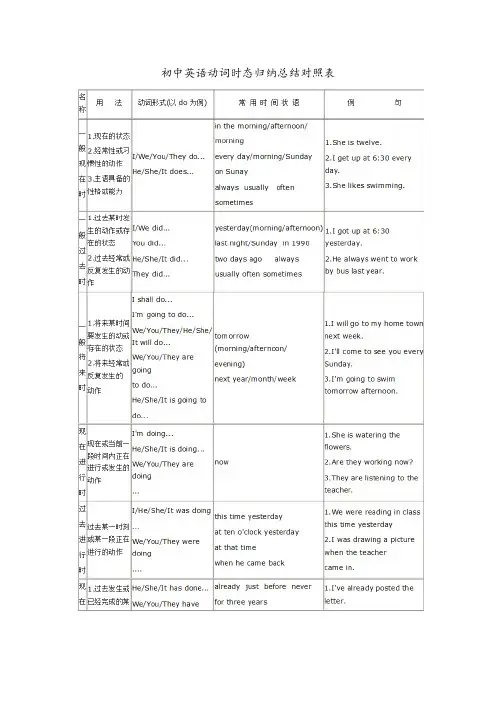
初中英语动词时态归纳总结对照表初中英语时态专项练习1、一般现在时。
通常用“usually, often, every day, sometimes”。
一般现在时基本用法介绍一、一般现在时的功能1.表示事物或人物的特征、状态。
如:The sky is blue.天空是蓝色的。
2.表示经常性或习惯性的动作。
如:I get up at six every day.我每天六点起床。
3.表示客观现实。
如:The earth goes around the sun.地球绕着太阳转。
二、一般现在时的构成: 肯定句:1).主语+系动词 be(is, am, are )+名词(形容词,介词短语)2) .其他主语+动词原形+其它第三人称单数+动词-s+其它如:I am a boy.我是一个男孩。
We study English.我们学习英语。
Mary likes Chinese.玛丽喜欢汉语。
三、一般现在时的变化否定句:1)主语+ be (is,am,are)+ not +其它。
如:He is not a worker.他不是工人。
2)其他主语+do not(don’t)动词原形+其它 I don't like bread 第三人称单数+does not(doesn’t)动词原形+其它He doesn't often play. 一般疑问句:1)Be(Is,Are) +主语+其它?如:-Are you a student? -Yes. I am. / No, I'm not. 2)Do其他主语+动词原形+其它? Does+第三人称单数+动词原形+其它+?注意:遇I/we—you, my—your, some—any. Does she go to work by bike? -Yes, she does. / No, she doesn't. Do you often play football?- Yes, I do. / No, I don't. 特殊疑问句:疑问词+一般疑问句。
(完整版)英语时态(初中英语动词时态归纳总结对照表).doc
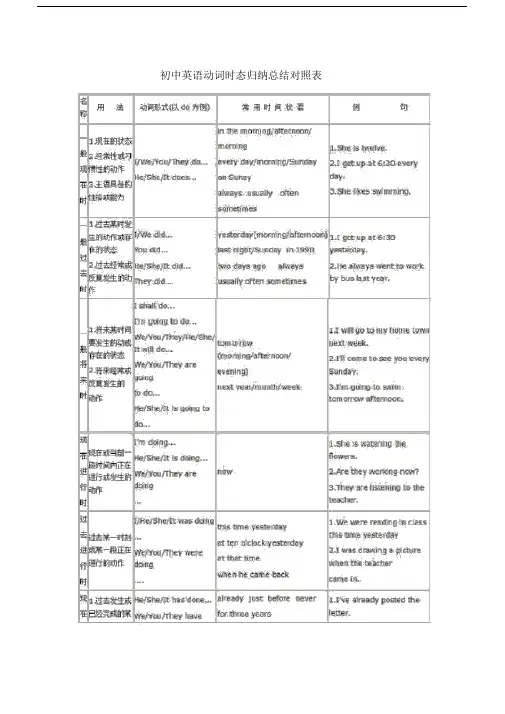
t_________ see________ buy _________ love____________ live_______二、用所给的动词的正
1.Su Hai took some photos at the Sports day.
否 定 句 :________________________________________________一 般 疑句 :
____________________________________________肯、否定回答:
______ (have) a party last Halloween.
4.Nancy ________ (pick) up oranges on the farm last week. 5. I ________ (make) a model ship w ith Mike yesterday.二、句型
否定句:主语+be(is,am,are)+not +动词现在分词-ing一般疑问句:Is(Are)+主语+动词现在分词-ing? 特殊疑问:疑问词+ be +主语+动词ing? 3.动词加ing的变化规则
1)一般情况下,直接加ing,如:cook-cooking
2)以不发音的e结尾,去e加ing,如:make-making, taste-tasting
3.表示客观现实。如:The earth goes around the sun.地球绕着太阳转。
二、一般现在时的构成:肯定句:
初中英语时态总结表
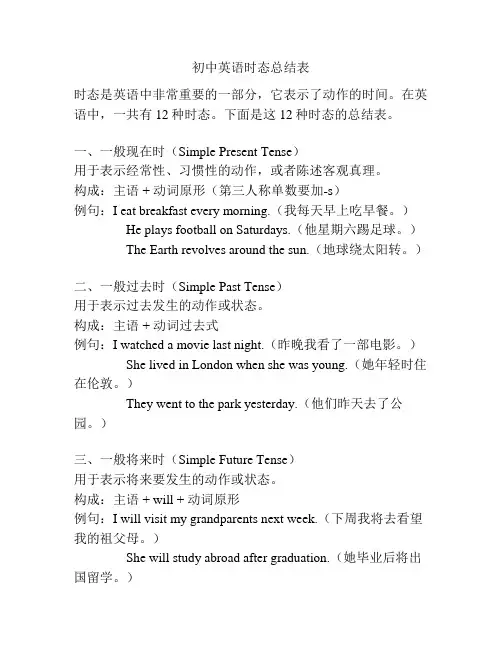
初中英语时态总结表时态是英语中非常重要的一部分,它表示了动作的时间。
在英语中,一共有12种时态。
下面是这12种时态的总结表。
一、一般现在时(Simple Present Tense)用于表示经常性、习惯性的动作,或者陈述客观真理。
构成:主语 + 动词原形(第三人称单数要加-s)例句:I eat breakfast every morning.(我每天早上吃早餐。
)He plays football on Saturdays.(他星期六踢足球。
)The Earth revolves around the sun.(地球绕太阳转。
)二、一般过去时(Simple Past Tense)用于表示过去发生的动作或状态。
构成:主语 + 动词过去式例句:I watched a movie last night.(昨晚我看了一部电影。
)She lived in London when she was young.(她年轻时住在伦敦。
)They went to the park yesterday.(他们昨天去了公园。
)三、一般将来时(Simple Future Tense)用于表示将来要发生的动作或状态。
构成:主语 + will + 动词原形例句:I will visit my grandparents next week.(下周我将去看望我的祖父母。
)She will study abroad after graduation.(她毕业后将出国留学。
)They will have a party on Friday.(他们将在星期五举行一个派对。
)四、现在进行时(Present Continuous Tense)用于表示现在正在进行的动作。
构成:主语 + am/is/are + 现在分词(-ing形式)例句:I am reading a book now.(我现在在读一本书。
)She is playing the piano at the moment.(她此刻正在弹钢琴。
初中英语时态一览表(完美版)
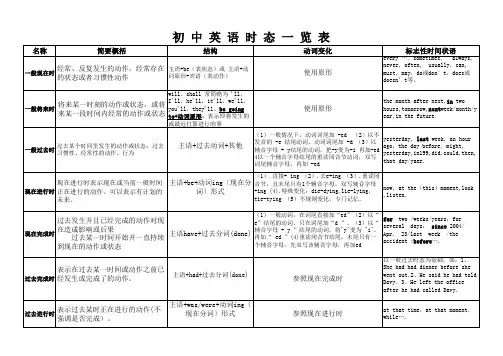
will、shall 常简略为 'll,
一般将来时
将来某一时刻的动作或状态,或将 来某一段时间内经常的动作或状态
I'll,he'll,it'll,we'll, you'll,they'll。be going to+动词原形,表示即将发生的
或最近打算进行的事
使用原形
the month after next,in two hours,tomorrow,nextweek/month/y ear,in the future.
参照现在完成时
以一般过去时态为基础,如:1、 She had had dinner before she went out.2、He said he had told Davy。3、He left the office after he had called Davy.
过去进行时
表示过去某时正在进行的动作(不 强调是否完成)。
yesterday, last week, an hour ago,the day before, might, yesterday,in199,did,could,then, that day/yaer.
现在进行时表示现在或当前一般时间 现在进行时 正在进行的动作。可以表示有计划的
未来。
(1).直接+ ing (2).去e+ing (3).重读闭
主语+was/were+动词ing〔 现在分词〕形式
参照现在进行时
at that time,at that moment, while….
经常、反复发生的动作,经常存在 的状态或者习惯性动作
主语+be(表状态)或 主语+动 词原形+宾语(表动作)
动词时态总结一览表
动词时态总结一览表现在时态- 一般现在时(Simple Present):表示经常性、惯性或普遍真理的动作或状态。
主语为第三人称单数时,动词需加 -s/-es 结尾。
一般现在时(Simple Present):表示经常性、习惯性或普遍真理的动作或状态。
主语为第三人称单数时,动词需加 -s/-es 结尾。
1. He drinks coffee every day. (他每天喝咖啡。
)2. They go to school by bus. (他们坐公交车上学。
)- 现在进行时(Present Continuous):表示正在进行的动作。
现在进行时(Present Continuous):表示正在进行的动作。
1. She is reading a book now. (她正在读书。
)2. We are watching TV at the moment. (我们现在正在看电视。
)- 现在完成时(Present Perfect):表示过去发生的动作对现在造成的影响。
现在完成时(Present Perfect):表示过去发生的动作对现在造成的影响。
1. I have finished my homework. (我已经完成了作业。
)2. They have lived here for two years. (他们在这里住了两年了。
)- 现在完成进行时(Present Perfect Continuous):表示动作从过去一直延续到现在。
现在完成进行时(Present Perfect Continuous):表示动作从过去一直延续到现在。
1. They have been playing basketball for two hours. (他们已经打了两个小时的篮球了。
)2. I have been studying English for five years. (我已经研究英语五年了。
)过去时态- 一般过去时(Simple Past):表示过去某个时间发生的动作或状态。
初中英语时态总结模板一览表.doc
初中英语语法总结一览表语法项目构成用法一般现在时主语 +动词原形或者表示经常性的第三人称单数 -s / es 动作或状态一般过去时主语 +动词过去式表过去某个、段时间内动( did 或者 be—was/ were 作及状态主语 +be going to +动词原在将来某个时间或一般将来时形某段时要做的事will / shall + 动词原形象征词Every ?often ?always on 天季、节、年。
Ago / just now / In 1998week / yesterday 等tomorrow / afternext / tonight ?in 2010例句in 月、He goes to school every day.I often have lunch at home./last He wrote a letter yesterday.I was born in 1979.Are you going to read?He will come tomorrow.现在进行时主语 +be(am/is/are) + doing 表此时此刻正进行的动作或状态现在完成时主语 +have / has + 动词过去发生在过去影响在现在的分词现在完成进行时动作或状态等主语 +have/has been+ doing.过去进行时主语 +was / were +doing 表在过去某时间正在进行多用于复合句中的动作过去完成时主语 +had+动过去分词该动作发生在过去的过去多用于复合句中过去将来时主语 +would + 动词原形过去看来将要发生的动作多用宾语从句中或状态listen?look?nowTom is writing now.all the time?Don ’ tThey are lying on the bed.含糊的频率副词 ?already?just?never everHe has slept for two days.I have been teaching for 8 years.at this time yesterdayHe was reading at that timelast Sunday eveninglast Fridayby the time +过去时We had learnt 2000 wordswhen?after?before by the end of?last year.He said that heHe said that he would come here the nextthe next day .day .。
(完整word版)初中英语动词在各种时态中的变化规则
实义动词在各种时态中的变化规则一、一般现在时当主语为第三人称单数时,实义动词变化如下:1、大多数动词在词尾直接加s,如read → reads ,look→ looks,play→ plays2、以辅音字母加y结尾的动词,要先将y变为i,再加es如:fly →flies carry →carries study →studies3、以“s, x, ch, sh”结尾的,在词尾加“es”,发音为[iz] 如:teach-teaches [iz]; watch-watches [iz] box---boxes4、以“o”结尾的动词,加“es”,读[z] 如:go-goes [z] do-does [z]5、特殊情况:have -- has二、一般过去时动词过去式分为规则和不规则形式(1)规则形式的变化规律及读音规则动词的过去式由“动词原形+-ed”构成,具体变化有:①直接在词尾加-ed。
-ed在浊辅音和元音后面读【d】;在清辅音后面读【t】;在发【t】和【d】音的字母后面一律读【id】如: want—wanted【id】, work—worked【t】, need—needed【id】, clean—cleaned【d】②以不发音的e结尾的在词尾加-d,读音同①如:like—liked【t】, live—lived【d】, move—moved【d】③以一个元音字母加一个辅音字母结尾的重读闭音节动词,先双写结尾的辅音字母,再加-ed。
如:stop—stopped,plan-planned,beg- begged,drop-dropped(1)如果重读在第一个音节处,不双写加ed. 如: visited(重读在vis前); offered(重读在of前);(2)如果重读在第二个音节处,双写词尾辅音字母加ed. 如: preferred(重读在fer前); admitted(重读在mit前); refer-referred,trip—tripped④以辅音字母加y结尾的动词,先把y变成i,再加-ed。
初中英语动词时态归纳总结对照表
初中英语动词时态归纳总结对照表初中英语动词时态归纳总结对照表初中英语动词时态语态归纳总结对照表名称一般现在时一般过去时 1.be+V-ing形式①tomorrow2.begoingto(morning/afternoon…+V-原形一般将来 3.will+V-原形②next时..③4.主语(I/We)year/month/week.+shall+原形inthefuture,④in+一段时间,⑤soon等will+be+p.p1.V-过去式2.be的过去式是was/were.yeste rday(morning/afternoon………)lastnight/year…in+过去年份,一段时间+ago,justnow.was/were+p.p1.有was/were时可以直加直提。
2.没有时,借助于助动词did,切记使用did后谓语动词要恢复原形.1.主语+be (am、/is/are)+表语2.主语(单三)+V-单三谓语结构标志词被动语态谓语结构助动词及疑否句构成am/is/are+p.everyday/morning….pusually,oftensometimes,always,onSundays1.有am/is/are时可以直加直提。
2.没有时,主语为单三时借助于does,非单三时借助于do。
切记使用助动词does后,动词应恢复原形。
Will和be可以直加直提。
现在进行时过去进行时Look!listen!now等am/is/are+V-ingam/is/are+being+p.pbe动词可以直加直提was/were①atthis/thattime+过去时间②at+时刻数+being+p.p+过去时间③from+时刻Was/were+V-ing数+to+时刻数+过去时间④主句(过去进行时)+when+从句(一般过去时)was/were可以直加直提①already,yet,ever,sofar,justbefore,never,twice,threetimes,thesedays,inthepast/lastfewyears,recently等have/has+动词过去分词②for+一段时间和since+过去时间③.主句(现在完成时)+since+从句(一般过去时)④Itis/hasbeen+一段时间+since+从句(一般过去时)have/has+been+p.p1.have/has可以直加直提2.already用在肯定句的句中或句末,而yet用在疑否句的句末。
- 1、下载文档前请自行甄别文档内容的完整性,平台不提供额外的编辑、内容补充、找答案等附加服务。
- 2、"仅部分预览"的文档,不可在线预览部分如存在完整性等问题,可反馈申请退款(可完整预览的文档不适用该条件!)。
- 3、如文档侵犯您的权益,请联系客服反馈,我们会尽快为您处理(人工客服工作时间:9:00-18:30)。
初中英语动词时态归纳总结对照表初中英语时态专项练习1、一般现在时。
通常用“usually, often, every day, sometimes”。
一般现在时基本用法介绍一、一般现在时的功能1.表示事物或人物的特征、状态。
如:The sky is blue.天空是蓝色的。
2.表示经常性或习惯性的动作。
如:I get up at six every day.我每天六点起床。
3.表示客观现实。
如:The earth goes around the sun.地球绕着太阳转。
二、一般现在时的构成: 肯定句:1).主语+系动词 be(is, am, are )+名词(形容词,介词短语)2) .其他主语+动词原形+其它第三人称单数+动词-s+其它如:I am a boy.我是一个男孩。
We study English.我们学习英语。
Mary likes Chinese.玛丽喜欢汉语。
三、一般现在时的变化否定句:1)主语+ be (is,am,are)+ not +其它。
如:He is not a worker.他不是工人。
2)其他主语+do not(don’t)动词原形+其它 I don't like bread 第三人称单数+does not(doesn’t)动词原形+其它He doesn't often play. 一般疑问句:1)Be(Is,Are) +主语+其它?如:-Are you a student? -Yes. I am. / No, I'm not. 2)Do其他主语+动词原形+其它? Does+第三人称单数+动词原形+其它+?注意:遇I/we—you, my—your, some—any. Does she go to work by bike? - Yes, she does. / No, she doesn't. Do you often play football ?- Yes, I do. / No, I don't. 特殊疑问句:疑问词+一般疑问句。
如:Where is my bike? How does your father go to work? 一般现在时用法专练:一、用括号内动词的适当形式填空。
1. He often ________(have) dinner at home.2. Daniel and Tommy _______(be) in Class One.3. We _______(not watch) TV on Monday.4. Nick _______(not go) to the zoo on Sunday.5. ______ they ________(like) the World Cup?二、按照要求改写句子1. Daniel watches TV every evening.(改为否定句)2. I do my homework every day.(改为一般疑问句,作否定回答)3. She likes milk.(改为一般疑问句,作肯定回答)7. I like taking photos in the park.(对划线部分提问)8. John comes from Canada.(对划线部分提问)三、改错(划出错误的地方,将正确的写在横线上) 1. Is your brother speak English? __________________ 2. Does he likes going fishing? _____ _____________ 3. He likes play games after class. __________________ 4. Mr. Wu teachs us En glish. __________________5. She don’t do her homework on Sundays. _________________ 2、现在进行时。
通常用“now/look/listen”.1.现在进行时表示现在正在进行或发生的动作,也可表示当前一段时间内的活动或现阶段正在进行的动作。
2.现在进行时的结构:.肯定句:主语+be(is,am,are ) +动词现在分词-ing eg: I am(not) doing my homework. You/We/They are(not) reading. He/She/It is(not) eating. 否定句:主语+be(is,am,are )+not + 动词现在分词-ing 一般疑问句:Is(Are)+主语+动词现在分词-ing?特殊疑问:疑问词+ be + 主语 + 动词ing? 3.动词加ing的变化规则1)一般情况下,直接加ing,如:cook-cooking2)以不发音的e结尾,去e加ing,如:make-making, taste-tasting3)如果末尾是一个元音字母和一个辅音字母,双写末尾的辅音字母,再加ing,如:run-running, stop-stopping,swim—swimming 4. 现在进行时专项练习:一、写出下列动词的现在分词:play________ run__________ swim _________make__________ go_________ like________ wr ite________ _ski___________ read________ have_________ sing ________ dance_________ pu t_________ see________ buy _________ love____________ live_______二、用所给的动词的正确形式填空:1.The boy __________________ ( draw)a picture now.2. Listen .Some girls _______________ ( sing)in the classroom .3. My mother _________________ ( cook )some nice food now.4. What _ ____ you ______ ( do ) now?5. Look . They _______________( have) an English lesson . 10.______Helen____________(wash )clothes? Yes ,she is . 三、句型转换:1. They are doing housework .(分别改成一般疑问句和否定句)2.The students are cleaning the classroom . ( 改一般疑问句并作肯定和否定回答)3.I’m playing the football in the playground .(对划线部分进行提问)①②3、一般过去时态一般过去时通常用“a moment ago, just now, yesterday, last…”等。
1.一般过去时表示过去某个时间发生的动作或存在的状态,常和表示过去的时间状语连用。
一般过去时也表示过去经常或反复发生的动作感谢。
2.Be动词在一般过去时中的变化:⑴am 和is在一般过去时中变为was。
(was not=wasn’t)⑵are在一般过去时中变为were。
(were not=weren’t)⑶带有was或were的句子,其否定、疑问的变化和is, am, are一样,即否定句在was或were 后加not,一般疑问句把was或were调到句首。
3.行为动词的一般过去时变化5.特殊疑问句:⑴疑问词+did+主语+动词原形?如: What did Jim do yesterday?⑵疑问词当主语时:疑问词+动词过去式?如:Who went to home yesterday? 过去时练习: 写出下列动词的过去式 is\am_________ fly_______ plant________ are ________ drink_________ play_______ go__ ______ make ________ does_________ dance________ worry________ ask _____ taste_______ __ eat__________ draw________ put ______ throw________ kick_________ pass_______ do __ ______ Be动词的过去时练习:A 一、用be动词的适当形式填空 1. I _______ at school just now. 2. He ________ at the camp last week. 3. We ________ studen ts two years ago. 4. They ________ on the farm a moment ago. 5. Yang Ling ________ eleven yea rs old last year. 二、句型转换 1. It was exciting.否定句:________________________________________________ 一般疑问句:____________________________________________ 肯、否定回答:__________________________________________ 2. All the students were very excited.否定句:________________________________________________ 一般疑问句:____________________________________________ 肯、否定回答:__________________________________________ 行为动词的过去时练习:B 一、用行为动词的适当形式填空1. He _________ (live) in Wuxi two years ago.2. The cat ________ (eat) a bird last night.3. We _ ______ (have) a party last Halloween.4. Nancy ________ (pick) up oranges on the farm last week.5. I ________ (make) a model ship w ith Mike yesterday. 二、句型转换1. Su Hai took some photos at the Sports day.否定句:________________________________________________ 一般疑问句:____________________________________________肯、否定回答:__________________________________________ 2. We sang some English songs.否定句:________________________________________________ 一般疑问句:____________________________________________ 肯、否定回答:__________________________________________ 三、中译英1.格林先生去年住在中国。
